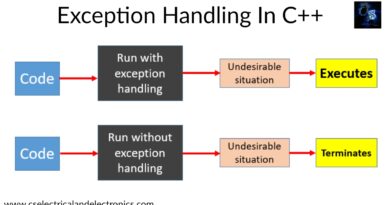Difference Between Transmission Line And Distribution Line
Hello guys, welcome back to my blog. In this article, I will discuss the difference between the transmission line and distribution line, what is the transmission line, what is the distribution line, the conductors used in transmission and distribution lines, etc.
If you have any electrical, electronics, and computer science doubts, then ask questions. You can also catch me on Instagram – CS Electrical & Electronics And Chetan Shidling.
Also read:
- What Is MPPT, Maximum Power Point Tracker, Types Of MPPT Algorithm
- Types Of Losses In PV System, Photovoltaic Losses, PV Losses
- Different Types Of Lithium-Ion Batteries, Working, Applications
Difference Between Transmission Line And Distribution Line
Why do We Need Transmission And Distribution Lines?
The transmission and distribution lines both will be used to transmit the power from one place to another place without any loss and with safety. The difference between the transmission and distribution lines can be explained on the basis of some factors such as their working principle, phase, voltage level and level of conduction, tower, etc.
Transmission lines
Transmission lines help to transfer electricity from the power plant to the substation. These lines can transmit three-phase power and carries a voltage of 66 kV or more. Transmission lines are overhead, but it will be more expensive if you want to install underground transmission cables. These also can transmit electricity from one end of the country to another end by interstate connections which means transmission lines are used for longer distances. These are high voltage lines.
High Voltage
The voltage for transmission lines varies from 66kv to 765kv. The power poles will be higher and the cables will be thicker as compared to distribution lines.
Bi-directional
Transmission lines are bi-directional which means electricity can flow in both directions. Normally electricity is transmitted to the demand area, but sometimes due to the low demand for electricity, the electricity is transmitted to another area. Due to low demand, the electricity generated will be transmitted to other states or countries. The national grid will manage this thing.
Maintenance
Transmission networks need to operate more actively compared to the distribution network. Maintenance of the transmission network can be done by automatic and manual interventions. Repair and fault location in the overhead transmission is easy, but in underground transmission lines, it is very difficult.
Structure
Steel towers are used in transmission lines. The steel tower carries or supports the overhead transmission lines.
Distribution lines
Distribution lines help to transfer electricity from substations to the consumer’s end. These cover shorter distances. These lines can transmit both single-phase power and three-phase power. usually, these lines carry voltage less than 66Kv. Distribution lines are again classified as high tension(HT) lines and low tension(LT) lines. High tension lines transfer energy from substation to distribution transformer. These lines are erected only on the main roads of cities. The high tension lines carry 11 kV voltage. It has three conductors (R, Y, B).
The low tension lines transmit power from the distribution transformer to the utilizer. It has four-conductor (R, Y, B, and N) three-phase conductors, and one neutral. It carries a three-phase voltage of 440 volts and a single-phase voltage of 230 volts.
Low voltage
The voltage for the distribution lines varies from 440 volts to 11 kV.
Mono directional
Traditionally, the distribution lines travel in only one direction that’s why the distribution network will not be designed to accommodate generation. In some places, smaller generation facilities like wind turbines and solar panels are plugged into the distribution network resulting in more stress on the distribution grid. The distribution lines always send energy to consumers.
Maintenance
The distribution lines are passive systems which mean operators or computer programs don’t manage these type of lines. Distribution lines do not require much maintenance as the power flow in the distribution lines is unidirectional.
Structure
The conductors in distribution lines are supported by RCC or PCC pole. The average height of the pole is 7 to 9 meters.
Difference Between Transmission And Distribution Lines
- Used for longer distances.
- Transmits power from generating station to the substation.
- Transmission lines have the capacity to carry high voltage.
- It carries 66 kV or more voltage.
- Transmission lines are overhead lines, but it will be more expensive to install underground lines.
- A steel tower is used to support the conductor.
- Used for shorter distances.
- Transmits power from the substation to the consumer area.
- Distribution lines have the capacity to carry low voltage.
- LT line carries 400 volts and the HT line carries 11 kV.
- Distribution lines are overhead or can be underground lines.
- PCC (plan cement concrete) or RCC (Reinforced cement concrete) poles are used to support the conductor.
Conductors Used In Over Head Transmission And Distribution Lines
In transmission lines and distribution lines, the conductors are made with aluminum alloy conductors like,
- All Aluminium Conductor (AAC)
- All Aluminium Alloy Conductor (AAAC)
- Aluminum Conductor Steel Reinforced (ACSR)
- Aluminum Conductor Aluminium-Alloy Reinforced(ACAR)
- Bundle Conductors
Transmission lines and the conductors are supported by steel Structures. Transmission towers are erected outside the cities because they carry high voltage.
I hope this article may help you all a lot. Thank you for reading.
Also read:
- Top 100 HiL hardware in loop Interview Questions With Answers For Engineers
- Top 100 Automotive Interview Questions With Answers For Engineers
- How Renewable Energy Is Transforming Electrical Engineering
- Exploring Electric Vehicles: Technology and Challenges
- The Future of Power Systems: Smart Grids
- What is XCP (Universal Measurement and Calibration Protocol)? Introduction, Working, Purpose, Applications
- What Is SIL Testing, Software-In Loop, Working, Purpose
- UDS (Unified Diagnostic Services) Tutorials For Automotive Engineers
Author Profile
- Chetu
- Interest's ~ Engineering | Entrepreneurship | Politics | History | Travelling | Content Writing | Technology | Cooking
Latest entries
 All PostsApril 19, 2024What Is Vector CANoe Tool, Why It Is Used In The Automotive Industry
All PostsApril 19, 2024What Is Vector CANoe Tool, Why It Is Used In The Automotive Industry All PostsApril 13, 2024What Is TCM, Transmission Control Module, Working, Purpose,
All PostsApril 13, 2024What Is TCM, Transmission Control Module, Working, Purpose, All PostsApril 12, 2024Top 100 HiL hardware in loop Interview Questions With Answers For Engineers
All PostsApril 12, 2024Top 100 HiL hardware in loop Interview Questions With Answers For Engineers All PostsMarch 22, 2024Driver Monitoring Systems In Vehicles, Working, Driver Sleepy Alert
All PostsMarch 22, 2024Driver Monitoring Systems In Vehicles, Working, Driver Sleepy Alert








